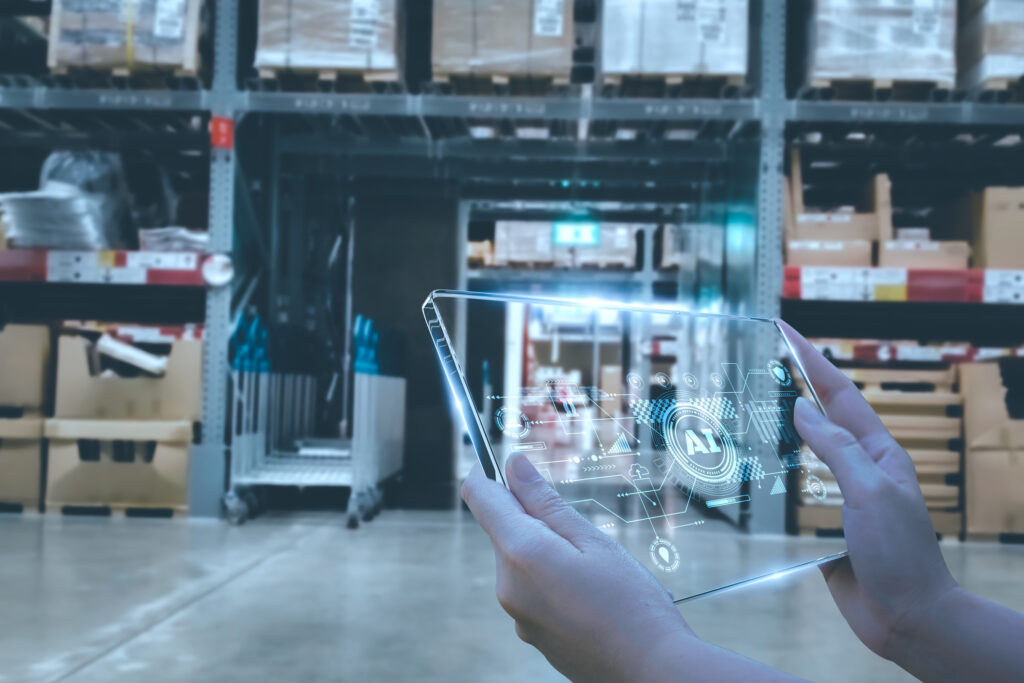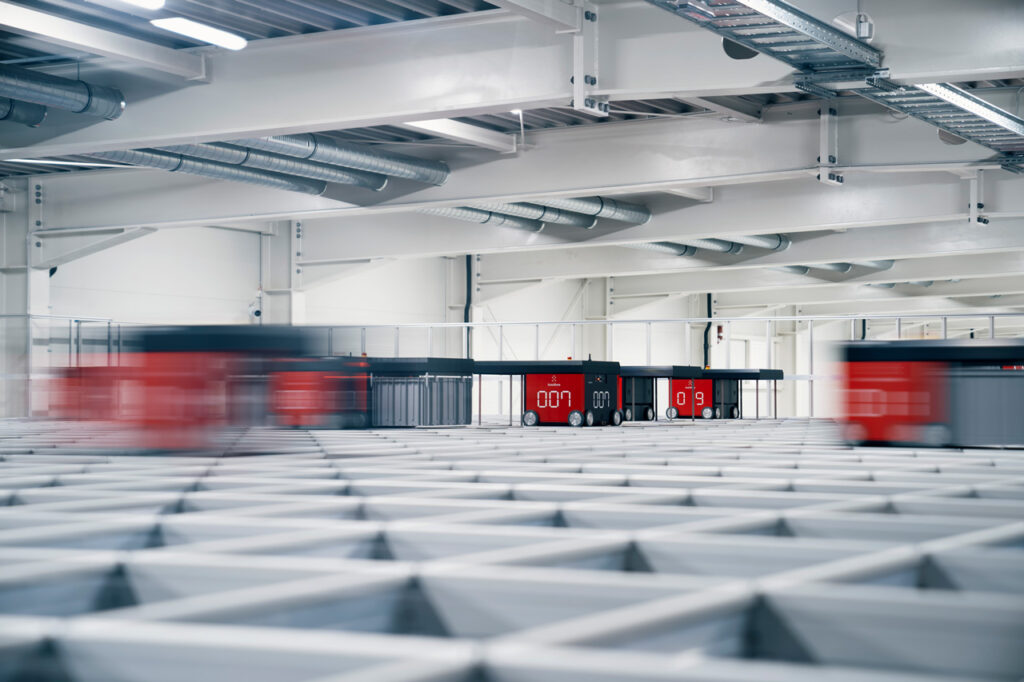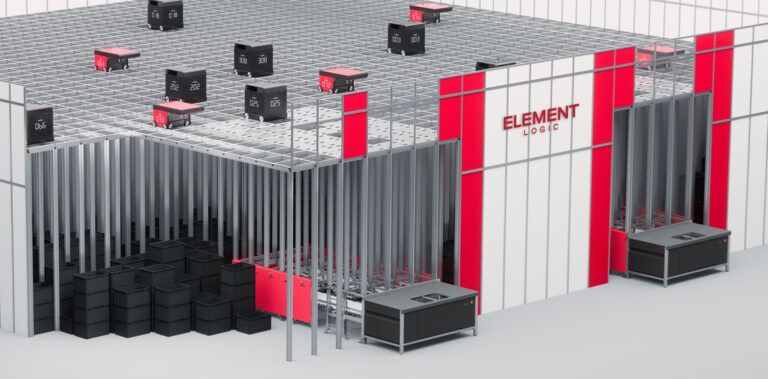What is Artificial Intelligence (AI)?
Artificial Intelligence, commonly abbreviated to AI, refers to the simulation of human intelligence in machines programmed to think, learn, and perform tasks that traditionally require human intelligence to perform. The overarching goal of AI is to develop complex systems that mimic various aspects of thought including problem-solving, reasoning, and learning.
What sets AI apart from your traditional computer program which follows predefined rules is that AI systems are designed to adapt and improve their performance over time through experience. This continual learning allows AI applications to span across different industries including healthcare, finance, supply chain distribution, logistics solution, and automation.
An Introduction to AI in Warehousing
Modern logistics and supply chain management is an incredibly dynamic landscape, one where the utilization of cutting-edge technologies is paramount to staying competitive and achieving operational excellence. As businesses grapple with the increasing complexities of global trade, e-commerce demands, and the need for unparalleled efficiency, artificial intelligence emerges as a transformative tool, offering unprecedented capabilities to enhance warehouse operations.
AI, with its ability to mimic human intelligence and learn from vast datasets, is ushering in a new era of smart warehouses. Gone are the days of static and rule-based systems; AI introduces adaptability, predictive analytics, and automation at a scale never witnessed before. From optimizing inventory management and order fulfillment to revolutionizing the maintenance of machinery and vehicles, AI is redefining how warehouses function.
This exploration into the realm of utilizing AI technology in warehouses delves into the current state of AI applications, highlights artificial intelligence in warehouses, machine learning in automation, future trends for artificial intelligence in the industry, and finally the challenges one may face. This journey will unravel the transformative power of AI, providing insights into its current capabilities and paving the way for a future where warehouses are not just spaces for storage but hubs of dynamic, intelligent operations. Let us embark on this exploration of AI’s role in warehouses, where innovation meets efficiency, and where the future of logistics unfolds before our eyes.

Current State of Warehouse Technology
In the fast-paced world of supply chain management, the efficiency and adaptability of warehouse operations stand as critical factors influencing overall success. Artificial intelligence lends an ever-adapting and ever-evolving hand in the development of these critical factors. As we dive further into AI’s various applications in this piece, we will also navigate the complex landscape that is modern logistics.
Here we will be looking at three key technologies that have emerged as cornerstones in shaping the current state of warehouse management. These technologies include Warehouse Management Systems (WMS), Radio-Frequency Identification (RFID) technology, and Automated Guided Vehicles (AGVs).
- Warehouse Management Systems
Warehouse management systems, better known as WMS, serve as the “nerve center” for modern warehouses. These software applications sort, execute, and optimize a plethora of tasks ranging from inventory management and order fulfillment, to tracking and reporting.
WMS not only streamlines day-to-day operations but also provides real-time visibility into warehouse activities, empowering decision-makers with actionable insights based on data point which become more precise overtime. The current state of warehouse technology is heavily reliant on robust WMS, acting as the backbone for seamless and efficient warehouse processes.
As WMS has continued to advance, we have seen more sophisticated features arise like real-time tracking (accurately measuring your current supply instead of estimating), demand forecasting, and advanced algorithms. These developments have led to an unprecedented era of warehousing, greatly reducing errors, minimizing costs, and increasing the overall efficiency of distribution centers.
- Radio Frequency Identification technology
Radio frequency identification technology, or RFID, has revolutionized how warehouses track and manage inventory. By utilizing radio-frequency signals to identify and track items in real-time, RFID eliminates the need for manual scanning and provides a level of accuracy and speed that is unattainable through traditional barcoding systems. In the current warehouse landscape, RFID plays a pivotal role in enhancing visibility, minimizing errors, and expediting the flow of goods through the supply chain.
By utilizing small RFID tags equipped with unique identifiers and radio-frequency antennas, warehouses can achieve unparalleled visibility into their stock. These tags are affixed to individual items, pallets, or containers, enabling real-time tracking throughout the entire warehouse ecosystem. Unlike traditional barcodes, RFID tags don’t require direct line-of-sight scanning, allowing for the simultaneous tracking of multiple items.
This not only accelerates processes such as receiving, picking, and shipping but also significantly reduces the margin for human error in data entry. RFID technology, with its ability to provide precise, automated, and real-time inventory information, has become a cornerstone in enhancing accuracy, operational efficiency, and overall inventory management strategies within warehouses.
- Automated Guided Vehicles (AGVs)
The integration of Automated Guided Vehicles represents a paradigm shift in material handling within warehouses. These autonomous, mobile robots are equipped with a variety of sensors and guidance systems, enabling them to navigate predetermined routes within a warehouse environment. AGVs are deployed for tasks such as transporting goods, picking up and delivering items, and replenishing inventory with unparalleled precision. Their ability to operate autonomously not only reduces the reliance on manual labor but also ensures consistency and reliability in the movement of goods.
AGVs contribute to streamlined workflows by optimizing routes and minimizing travel times, thereby enhancing overall operational efficiency. As warehouses continue to embrace automation, AGVs play a pivotal role in creating adaptive and agile environments capable of meeting the demands of modern supply chain dynamics.
Integration of AI in the current warehouse landscape

Now that we understand some of the most common technologies utilized in the warehousing industry, let’s look towards where artificial intelligence is being applied to!
- AI-powered analytics
In the contemporary warehouse environment, the integration of AI-powered analytics has become a cornerstone for data-driven decision-making. AI algorithms sift through vast amounts of data generated by various warehouse processes, offering valuable insights that human analysis might overlook. These algorithms save companies thousands of hours of manual labor in just a matter of a fraction of the time.
Analytics enhance efficiency by providing real-time visibility into inventory levels, order fulfillment, and other critical operations. AI-driven analytics not only enable a more proactive approach to problem-solving but also contributes to strategic planning, optimizing resource allocation, and ultimately improving overall warehouse performance.
- Predictive maintenance using AI
The implementation of AI for predictive maintenance has redefined how warehouses manage and maintain their equipment. AI algorithms analyze data from sensors and machinery, predicting potential failures or maintenance needs before they occur. This proactive approach minimizes downtime, reduces the risk of unexpected breakdowns, and extends the lifespan of equipment.
Predictive maintenance using AI not only optimizes operational efficiency but also leads to cost savings by avoiding costly repairs that result from reactive maintenance approaches. This integration of AI ensures that warehouse machinery operates at peak performance, contributing to a more reliable and resilient warehouse infrastructure.
- Robotics and automation
The synergy between AI and robotics has revolutionized warehouse operations, introducing a new era of automation. AI-powered robots operate collaboratively with human workers, performing tasks ranging from routine material handling to intricate order picking. These robotic systems leverage AI algorithms for navigation, allowing them to adapt to changing environments and optimize routes for maximum efficiency.
The result is a streamlined and agile warehouse ecosystem where robots and automation enhance productivity, reduce labor costs, and significantly decrease the time required for tasks like inventory management and order fulfillment. The integration of AI in robotics paves the way for warehouses to achieve higher levels of precision and responsiveness in their day-to-day operations.
Machine Learning in Warehouse Management
Machine Learning (ML) is a specialized field within artificial intelligence that revolves around the development of algorithms and statistical models allowing computers to learn from data without explicit programming. This subdivision of AI enables machines to recognize patterns, make predictions, and adapt their behavior based on the information they encounter.
Essentially, machine learning models are “trained” on large datasets, where the algorithm learns to map out input features to corresponding output labels. The training process involves adjusting the model’s parameters to minimize the difference between its predictions and actual outcomes. There are four types of machine learning, supervised learning, semi-supervised learning, unsupervised learning, and reinforcement learning.
- Supervised learning involves training models on labeled data. Essentially being taught by example.
- Semi-supervised learning involves training with both labelled and unlabeled data, which better enables algorithms to learn how to label unlabeled data.
- Unsupervised learning deals with unlabeled data where the program must identify patterns on its own.
- Reinforcement learning enables the machine to learn by interacting with an environment and receiving rewards or penalties based on their actions. It is usually given a set of parameters, actions, or end values to evaluate its growth.
The relationship between AI and ML is a symbiotic one. Machine learning serves as a fundamental component of AI, empowering systems to adapt, improve, and make intelligent decisions based on experience. Applications of ML within AI are diverse, spanning natural language processing, image recognition, recommendation systems, and many other areas, showcasing its crucial role in creating intelligent and adaptive systems.
The relationship between AI and ML is a symbiotic one. Machine learning serves as a fundamental component of AI, empowering systems to adapt, improve, and make intelligent decisions based on experience. Applications of ML within AI are diverse, spanning natural language processing, image recognition, recommendation systems, and many other areas, showcasing its crucial role in creating intelligent and adaptive systems.
Applications of machine learning in warehouse processes
Machine Learning is increasingly becoming a game-changer in optimizing warehouse processes, offering advanced solutions to enhance efficiency, accuracy, and overall operational effectiveness, much like AI as described above. Here are specific applications of machine learning in warehouse processes:
- Dynamic Slotting for Efficient Space Utilization:
In warehouse management, dynamic slotting involves the intelligent placement of products within a warehouse based on factors such as demand, size, weight, and picking frequency. Machine learning algorithms excel in this area by analyzing historical data, real-time order trends, and other variables to determine the optimal location for each product.
By continuously learning from changing demand patterns and operational dynamics, ML algorithms can dynamically adjust product locations, ensuring that high-demand items are strategically placed for quick and efficient access. This not only maximizes space utilization but also minimizes travel time during order picking, resulting in improved overall warehouse productivity.
An example of this would be the slotting capabilities of AutoStore.

- Quality Control and Defect Detection:
Machine learning applications revolutionize the traditional methods of visual inspection in warehouses, which drastically improved our methods for quality control and defect detection. Computer vision, a subset of ML, is employed to analyze images or videos of products, identifying defects, damages, or irregularities with high precision.
Machine learning algorithms can be trained on labeled datasets to recognize patterns associated with quality issues, enabling the automated inspection of items during the receiving or packing processes. This not only accelerates the inspection process but also significantly reduces the likelihood of human error. Implementing ML in quality control ensures that only products meeting predefined quality standards proceed through the supply chain, ultimately enhancing customer satisfaction and minimizing returns.
- Supplier Performance Analysis:
Machine learning contributes to efficient supplier performance analysis by leveraging data from various sources, including order history, delivery times, product quality, and customer feedback. ML algorithms can assess and analyze this data to evaluate supplier performance, identifying patterns and trends that may not be immediately apparent through traditional methods.
By predicting and preventing potential issues such as delays or quality discrepancies, machine learning enables warehouses to proactively manage relationships with suppliers. This data-driven approach facilitates strategic decision-making, including supplier selection, contract negotiation, and overall supply chain optimization. Machine learning’s ability to process and analyze large datasets enhances the accuracy and efficiency of supplier performance analysis, contributing to a more resilient and responsive supply chain.
Challenges and Considerations
Implementing Artificial Intelligence (AI) in warehouses holds tremendous potential for revolutionizing operations, but it also comes with its set of challenges that businesses need to navigate carefully. Below are some of the key challenges some people may face when implementing AI technology in their warehouses.
- Cost considerations
- The deployment of AI technologies involves substantial upfront costs for acquiring hardware, software, and expertise in AI development and integration.
- Small to medium-sized businesses may find it challenging to justify the initial investment, impacting the widespread adoption of AI in warehouses.
- Continuous updates, maintenance, and monitoring are essential for the effective functioning of AI systems.
- The ongoing costs associated with system maintenance and the need for periodic upgrades can strain budgets, requiring businesses to carefully weigh the long-term financial implications.
- Workforce adaptation and training
- Integrating AI into warehouse operations necessitates a workforce with the skills to operate and manage these technologies.
- There may be a significant gap between the current skill sets of warehouse personnel and the expertise required to effectively use and maintain AI systems.
- Employees might resist the adoption of AI due to concerns about job displacement or fear of technology.
- Overcoming resistance requires comprehensive change management strategies and initiatives to educate and involve the workforce in the AI implementation process.
- Data security and privacy concerns
- Warehouses generate and handle vast amounts of sensitive data, including inventory details, customer information, and operational statistics.
- AI systems, particularly those relying on cloud services, pose potential vulnerabilities to data breaches, exposing confidential information to security threats.
- Adhering to data protection regulations and ensuring compliance with industry standards become crucial when implementing AI in warehouses.
- Striking a balance between leveraging AI for operational benefits and safeguarding customer privacy requires a nuanced understanding of evolving legal frameworks.

Strategies to overcome challenges and maximize AI benefits
To overcome the challenges associated with implementing AI in warehouses and maximize the benefits of this transformative technology, businesses can adopt several strategic approaches.
First and foremost, a comprehensive and well-executed change management plan is essential. This involves fostering a culture of innovation within the organization and ensuring that all stakeholders, from top management to frontline workers, are aligned with the goals of AI implementation.
Providing continuous training programs to upskill the workforce and dispel fears about job displacement helps build a workforce that is not only accepting of AI technologies but also actively engaged in their effective utilization. Open communication channels, regular updates, and a transparent approach to the integration process can mitigate resistance and create a collaborative environment.
Additionally, partnering with AI solution or smart technology providers, leveraging cloud services, and exploring collaborative initiatives within the industry can alleviate some financial burdens and facilitate the sharing of best practices. By adopting a strategic, step-by-step approach, businesses can harness the transformative power of AI while minimizing risks and ensuring a smoother integration process.
Conclusion
In conclusion, the integration of AI in the warehousing industry marks a paradigm shift towards smarter, more efficient operations. From optimizing inventory management and enhancing order fulfillment to revolutionizing quality control and supplier performance analysis, AI technologies offer unparalleled opportunities for businesses to stay competitive in a rapidly evolving landscape. While challenges such as cost considerations, workforce adaptation, and data security exist, strategic planning and phased implementation can pave the way for successful AI adoption.
To unlock the full potential of your warehouse and embark on a journey towards heightened efficiency and innovation, consider reaching out to SDI Element Logic. Our smart technology solutions transform your warehouse into a hub of intelligent and adaptive operations. Explore the possibilities, stay ahead of the curve, and revolutionize your warehousing experience with SDI Element Logic’s cutting-edge technologies. Contact us today to learn more about how our solutions can elevate your warehouse management to new heights.

When Does AutoStore Make Sense for Your Business?
Article by Cory Clifford In the ever-changing landscape of logistics and supply chain, it is important to stay on top of the latest technologies. AutoStore

The Benefits of Automating Your Warehouse with AutoStore
Learn what an AutoStore is and how it can benefit your warehouse. Whether you are e-commerce, or wholesale, AutoStore can help you improve business.
